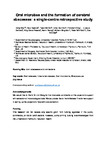Oral microbes and the formation of cerebral abscesses: a single-centre retrospective study
| dc.contributor.author | Roy, Holly | |
| dc.contributor.author | Bescos Garcia, Raul | |
| dc.contributor.author | McColl, Ewen | |
| dc.contributor.author | Rehman, U | |
| dc.contributor.author | Cray, E | |
| dc.contributor.author | Belfield, Louise | |
| dc.contributor.author | Nweze, K-D | |
| dc.contributor.author | Tsang, K | |
| dc.contributor.author | Singleton, W | |
| dc.contributor.author | Whitfield, P | |
| dc.contributor.author | Brookes, Zoe | |
| dc.date.accessioned | 2022-11-25T09:20:36Z | |
| dc.date.issued | 2022-11 | |
| dc.identifier.issn | 0300-5712 | |
| dc.identifier.issn | 1879-176X | |
| dc.identifier.other | 104366 | |
| dc.identifier.uri | http://hdl.handle.net/10026.1/20012 | |
| dc.description.abstract |
Objective Intracranial abscesses are relatively uncommon, but can result in significant mortality and morbidity. Whilst many potential causes of brain abscesses are recognised, in many cases the origin of infection remains clinically unidentified. Our objective was to investigate the role of bacteria found in the oral cavity in the development of brain abscesses. Methods A retrospective analysis was performed using data from 87 patients admitted to a single UK neurosurgical unit with brain abscesses over a 16-year period. Using microbiological data obtained from abscess sampling and peripheral cultures, species of bacteria were categorised in patients where no primary source of infection was identified (NSI) for their brain abscess (n = 52), or where an infective source (ISI) was identified. The microbiological data was then screened to identify common oral bacteria in each group. Results Brain abscesses from the ISI group (n = 35) demonstrated a significantly lower preponderance of oral bacteria (n = 8), than the NSI group (n = 29) (p < 0.05). Brain abscesses from the NSI group also had significantly higher counts of Streptococcus anginosus compared to ISI (p < 0.05), with brain abscesses being most common in the frontal and parietal lobes for both ISI and NSI. Conclusions These findings suggest that the oral cavity could be considered as a source of occult infection in cases of brain abscess where no clear cause has been identified. Future studies should include oral screening and microbiome analysis to better understand the mechanisms involved and develop approaches for prevention. Clinical significance statement Oral bacteria may be an under-recognised cause of brain abscesses. Careful review of oral health in brain abscess patients may help establish causation, particularly in patients with no cause for their abscess identified. Good levels of oral health may help prevent the development of brain abscesses in some individuals. | |
| dc.format.extent | 104366-104366 | |
| dc.format.medium | Print-Electronic | |
| dc.language | en | |
| dc.language.iso | eng | |
| dc.publisher | Elsevier BV | |
| dc.subject | Brain abscess | |
| dc.subject | Intracranial abscess | |
| dc.subject | Oral microbiome | |
| dc.subject | Streptococcus anginosus | |
| dc.title | Oral microbes and the formation of cerebral abscesses: a single-centre retrospective study | |
| dc.type | journal-article | |
| dc.type | Journal Article | |
| plymouth.author-url | https://www.webofscience.com/api/gateway?GWVersion=2&SrcApp=PARTNER_APP&SrcAuth=LinksAMR&KeyUT=WOS:000992451100001&DestLinkType=FullRecord&DestApp=ALL_WOS&UsrCustomerID=11bb513d99f797142bcfeffcc58ea008 | |
| plymouth.volume | 128 | |
| plymouth.publication-status | Published | |
| plymouth.journal | Journal of Dentistry | |
| dc.identifier.doi | 10.1016/j.jdent.2022.104366 | |
| plymouth.organisational-group | /Plymouth | |
| plymouth.organisational-group | /Plymouth/Faculty of Health | |
| plymouth.organisational-group | /Plymouth/Faculty of Health/Peninsula Dental School | |
| plymouth.organisational-group | /Plymouth/Faculty of Health/School of Health Professions | |
| plymouth.organisational-group | /Plymouth/REF 2021 Researchers by UoA | |
| plymouth.organisational-group | /Plymouth/REF 2021 Researchers by UoA/UoA03 Allied Health Professions, Dentistry, Nursing and Pharmacy | |
| plymouth.organisational-group | /Plymouth/Research Groups | |
| plymouth.organisational-group | /Plymouth/Research Groups/Institute of Health and Community | |
| plymouth.organisational-group | /Plymouth/Research Groups/Plymouth Institute of Health and Care Research (PIHR) | |
| plymouth.organisational-group | /Plymouth/Users by role | |
| plymouth.organisational-group | /Plymouth/Users by role/Academics | |
| dc.publisher.place | England | |
| dcterms.dateAccepted | 2022-11-15 | |
| dc.rights.embargodate | 2022-12-23 | |
| dc.identifier.eissn | 1879-176X | |
| rioxxterms.versionofrecord | 10.1016/j.jdent.2022.104366 | |
| rioxxterms.licenseref.uri | http://www.rioxx.net/licenses/all-rights-reserved | |
| rioxxterms.licenseref.startdate | 2022-11-16 | |
| rioxxterms.type | Journal Article/Review |


